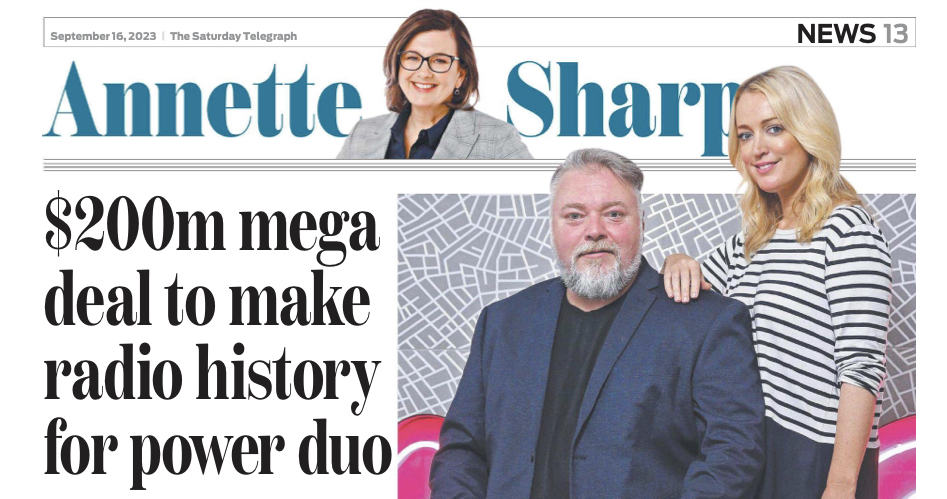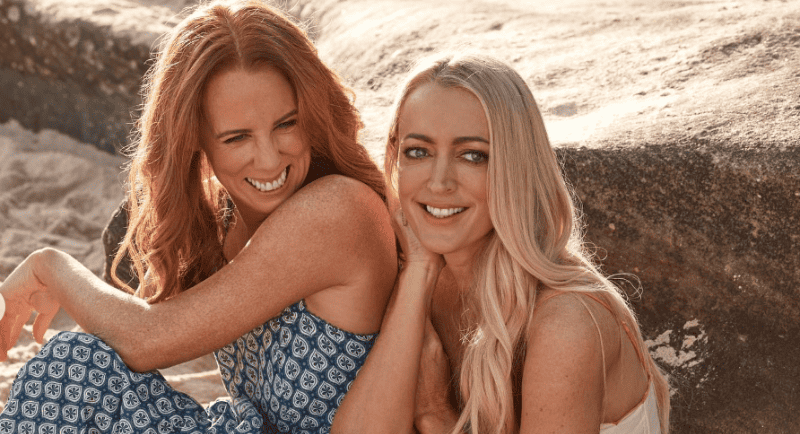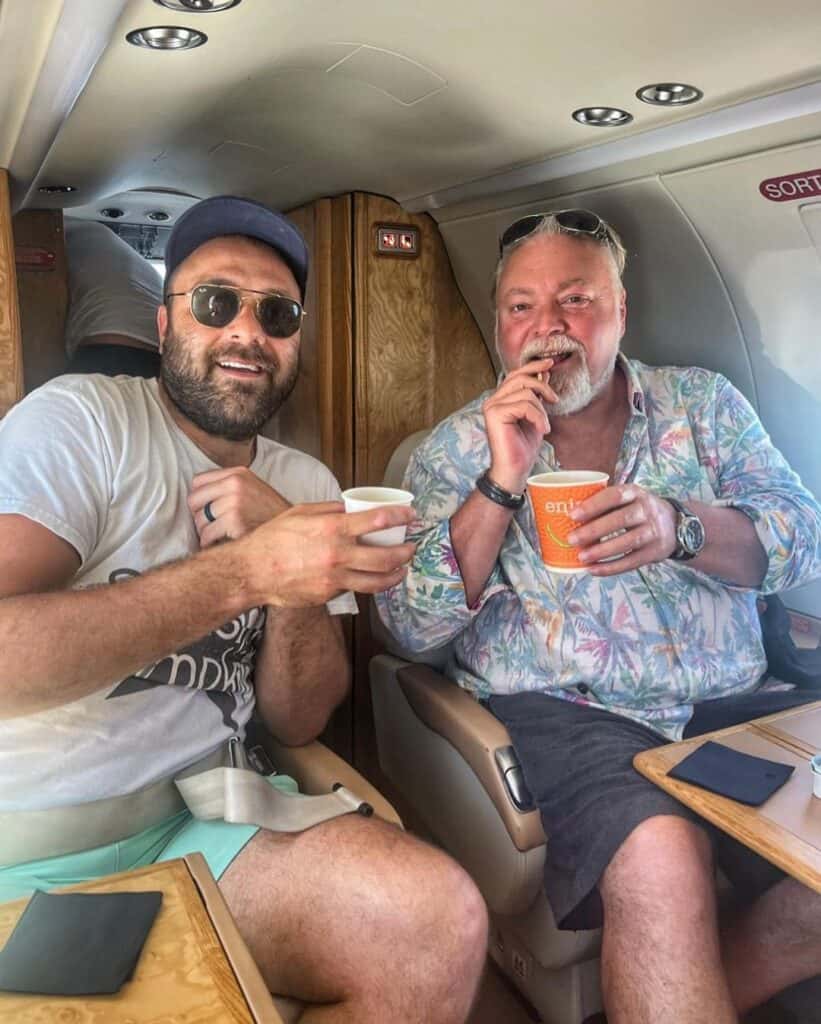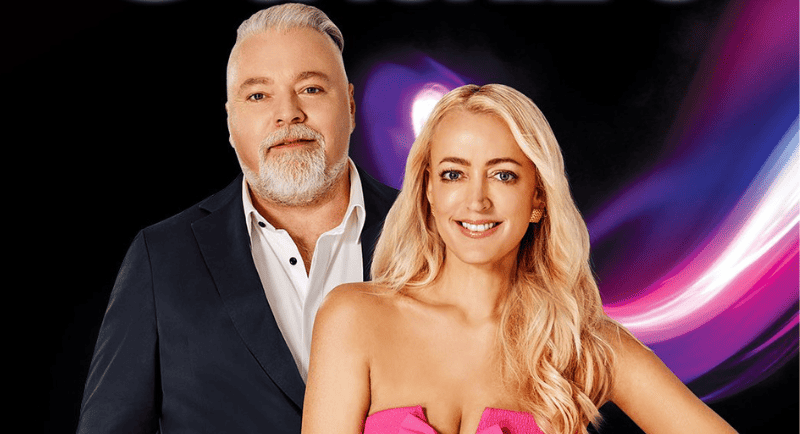When The Daily Telegraph splashed news about Kyle and Jackie O’s new radio contract across its front page the first reaction of many in the industry was “as if”.
News Corp celebrity columnist Annette Sharp reported on Saturday that Sydney’s #1 FM radio team was insisting “on a massive $200 million joint deal to remain at KIIS for another 10 years”.
At first glance, this seemed like a very ambitious overreach in a new contract negotiation.

Kyle Sandilands and Jackie Henderson are already the highest-paid talent in Australian media with an estimated $5m each annually, plus incentives, for their radio work. That salary is topped up by extras like TV work and commercial endorsements.
Sandilands runs his own King Kyle business and this year Henderson revealed entrepreneurial flair with the launch of the Besties business.
Radio insiders however have indicated that the battle to resign the duo has been underway for some time with ARN and their former employer SCA both in it, almost literally, up to their necks.
There is speculation both broadcast networks are ready to meet the new demands, with the radio hosts now having to decide to stay at their current home, or return to Sydney’s Hit Network station 2DayFM.

ARN v SCA: Who can best afford $200m?
There is not a lot separating the competing ambitions of Australia’s two biggest commercial radio networks. SCA has the edge in terms of the number of stations with 99 and representation for another 34, while ARN has close to 60 stations in over 30 markets.
In terms of radio revenue, SCA is in front again with $372m in FY 22/23, delivering earnings of $92.2m. ARN posted revenue of $315m in its FY22 delivering earnings of $86.5m.
Both companies are building ambitious digital plays packed with podcasts that are still losing money. SCA’s LiSTNR burned through $15.2m last financial year, while ARN’s iHeartPodcast network lost $12m. Both media companies are forecasting profitability for those divisions by the end of 2024. The addition of The Kyle and Jackie O Show podcast would help speed both outfits toward profitability.
In the past, Sandilands told Mediaweek he and Jackie may not always be with a traditional radio broadcaster: “I have [previously] had a conversation with the head of Spotify in the US. A very informal chat about radio and what we do on our show. Also, Amazon has asked where are we at with contracts. I have said I am really happy on radio at the moment.
“iHeartRadio is doing well for us and gets the reach out around the world which I love. I am really happy with ARN, but I don’t know what the future holds. The show may stay with ARN, iHeartRadio might turn into something different, or Amazon may come along and say we’ll give you all this.
“[Any new deal] won’t be just money driven. I don’t want it to be too hard or for people to have to pay to hear us. We should always be free. I don’t mind if it was on a platform. If iHeartRadio said they want to film it like TV and then charge people to watch it, I’d say that’s OK.”
See also: Insiders guide to Australia’s #1 commercial FM radio show

Gemma O’Neill with Jackie Henderson
Kyle and Jackie O contract negotiation teams
The radio announcers each have a management team. Kyle Sandiland’s day-to-day manager is former radio producer Bruno Bouchet who is also managing director of the King Kyle group.
Jackie Henderson is looked after by former radio producer-turned-network executive Gemma O’Neill who is also managing director of Besties Australia.
When it comes to contract time though, the hosts really role up their sleeves.
In a revealing interview with Mediaweek at the end of their first contract period with ARN, Sandilands explained how contract talks begin and who is in the room:
“Ciaran Davis [ARN chief executive] and Duncan Campbell [ARN chief content officer] from ARN, and myself with [manager] Bruno and Greg Sitch, our lawyer and one of the best entertainment lawyers in the world. I will go to the first meeting where it is all just cakes and smiles. I will leave and tell Greg and Bruno what I want and how I want it.
“They will then argy-bargy back and forth because I can’t put up with it. My demands are always fair, never outrageous. A lot of other people will think it is outrageous.” He’s not wrong this time around too!
Sandilands explained the ARN contract with the radio stars runs to 300 pages. The fine print print includes can’t be fired for any reason. “That’s right,” he explained. “It’s always somebody else’s fault, not mine.”
Sandilands and Henderson claim to sign off on every KIIS employee that comes and goes, “including senior management”. Sandilands added: “They can’t sell the place and have some loser show up. I have to agree.”

Bruno Bouchet with Kyle Sandilands
Sex sells, so less censorship?
In Annette Sharp’s News Corp report, she noted the hosts were hoping for “less censorship”. That is something that will be hard to change as it’s almost become a broadcast licence requirement for a show that drifts close to the edge on most days of the week.
The Kyle and Jackie O show employs censors who have hands hovering above dump buttons to take any potentially license-threatening content off the air. Some regular listeners are surprised how little that dump button is activated with regular revelations about the sexual habits of the hosts, their over-sharing staff and even more oversharing listeners going to air.
Mediaweek is way too prudish to give any more detail, but it’s one of the decisions any new employer needs to make. What is their appetite for revealing sexcapades and how might that impact any commercial agreements.
Howard Stern money
In terms of the Australian market, Kyle and Jackie are certainly in the same league as US broadcaster Howard Stern. In 2020 it was reported by the Associated Press that Stern reached a five-year deal with SiriusXM to continue making his show for the satellite radio company through the end of 2025.
Terms were not disclosed. However, Forbes magazine has reported that Stern was already making US$90 million a year. With a population nearly 14 times the size of Australia, that puts the KIIS hosts on a similar footing.
Sandilands revealed in the past the hosts get bonus payments that are triggered from survey to survey. Those include extra dollars when ranked #1 FM, also something he called a “share of profits” bonus. During 2020 when there were less radio surveys, there were fewer #1 FM bonus payments.
On the other side, ARN “fines” Sandilands when he takes more than an agreed number of sick days. That explains why recently he has been on-air despite not sounding one hundred percent.
How much does he lose? Quite a bit. Sandilands revealed how much he was penalised financially for missing a show. “$28,000 a day it costs me [in 2020]. I only get 11 sick days a year. Last year they penalised me $250,000.”
